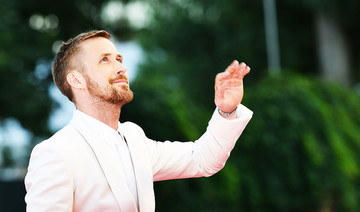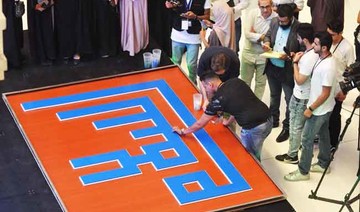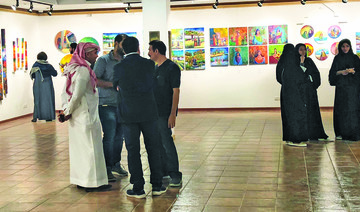VENICE: Long before Saudi Arabia reopened its cinemas earlier this year, Haifaa Al-Mansour had made her first movie, “Wadjda,” which premiered at the 2012 Venice film festival.
Al-Mansour had told me then that her entire directorial exercise had been a real struggle: She had to sit inside a van and shout her instructions through a microphone. The movie suffered, but when she premiered “Mary Shelly” in 2017, the progress was for all to see.
Her latest outing is “The Wedding Singer’s Daughter,” a short film that screened at the 75th edition of the Venice film festival last week. The film is a neat work of art and features a girl who saves her mother from embarrassment during a traditional Saudi wedding.
Here, much like her first film’s young protagonist, a child (played by Haylie Neimann) becomes a hero when she gets up on a table to fix a microphone so her mother (played by Saudi singer Rotana Tarabzouni) can continue singing.
Neimann is a natural and acts with her eyes, something that is very rare these days. It is clear that Al-Mansour’s attention was totally on the little girl, which is not a bad thing, but maybe a bit more camera time for the singer could have balanced out the work a little more evenly.
Although it is understandable that priorities must be chosen in such a short film — this one runs for about eight minutes — a little more creativity in the editing room could have made the feature a more satisfying watch.
The film captures the essence of society, with Al-Mansour publicly stating that “weddings are the actual mirror of the society in Saudi Arabia: Segregated, fragmented, along gender and class.
“I wanted to tell the story of those people and capture that tenderness,” she added.
And that she does with finesse. We see how the daughter ignores the scornful barbs of guests at the wedding and uses her imagination, like an independent movie director, to fix the power problem.
In the process, with one simple act, Al-Mansour once again creates an unlikely heroine.
Film review: An imaginative approach to capturing tension on screen
Film review: An imaginative approach to capturing tension on screen
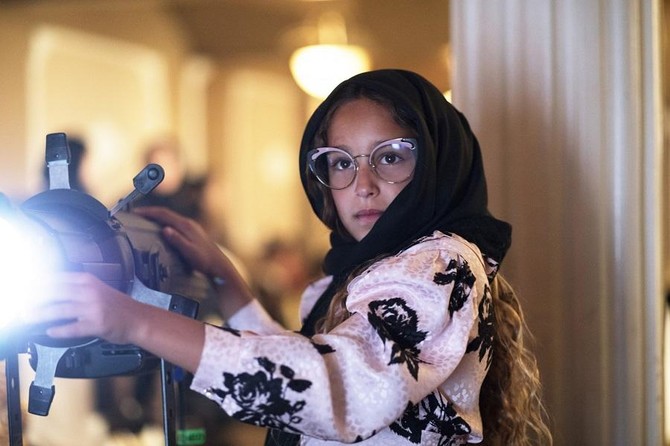
London show hosts the first Saudi woman specializing in Islamic designs
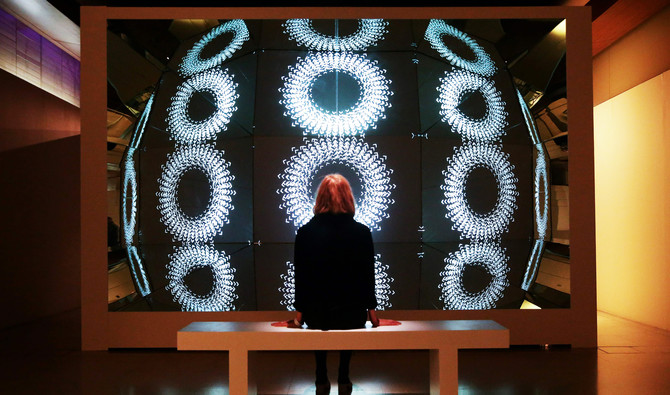
- The exhibition showcases the work of leading designers and innovators from 40 countries
- Al-Homoud: My presence at the London Design Biennale is a great responsibility but is also a source of pride for me, because I am able to represent part of the Saudi creativity in a world-class event
JEDDAH: Artist Lulwa Al-Homoud is the first Saudi woman to have her work displayed in front of a British audience, at the London Design Biennale, which runs at Somerset House in London from Sept. 4 to 23.
The exhibition showcases the work of leading designers and innovators from 40 countries, focusing this year on how design influences our emotions and experiences.
Lulwa’s sculptures incorporate the beautiful calligraphy techniques of Arabic alphabets to create complex geometric patterns as a means of conveying positive emotional feelings. Ali Al-Mutairi, director of Ithra (the King Abdulaziz Center for World Culture in Dhahran), said: “We are delighted at Ithra to support Lulwa Al-Homoud in this unique cultural event. Our goal is to develop and deliver innovative artistic and knowledge products in a way that respects diversity and promotes different concepts in science and arts.”
He added: “We are also proud that one of Lulwa’s works is displayed at the Contemporary Arts Hall at the Ithra Museum in Dhahran, stressing that this initiative achieves the center’s mission in spreading knowledge and supporting creativity and cultural communication with the world, through Saudi elites and national talents in international forums.”
Al-Homoud’s participation at the London event sponsored by Ithra, which is an initiative by Saudi Aramco aims to promote local culture, innovation and talents.
During a conversation with the audience, Al-Homoud said: “My presence at the London Design Biennale is a great responsibility but is also a source of pride for me, because I am able to represent part of the Saudi creativity in a world-class event that highlights countries more than individuals. We, as artists, are the product of the cultures of our countries, and Ithra’s support adds to my responsibility, pride and gratitude to my homeland.
“Arabic calligraphy is at the top of the pyramid of Islamic arts. It started to develop the Qur’anic text, and calligraphers did their best to try to make it as beautiful as possible, in order to match the beauty of the text. The language can spread feelings of love and anger, sadness and peace. This design is a trial to gather the public around one opinion in an abstract way.”
The work “Existence and Being” manifests the relation between languages and our emotional state; it explores how languages influence us through the messages we try to convey. She also developed an abstract form of the Arabic language, molding it in geometrical patterns, creating a complex and symmetrical alignment of symbols and lines.
It is worth mentioning that Al-Homoud graduated in sociology in Riyadh and then went on to continue her master’s degree at Central St. Martins in London. She became the first Saudi woman to specialize in Arabic calligraphy and Islamic designs. Her participation in the London Biennale was the result of her research in Arabic calligraphy and Islamic designs.
Her work has been exhibited in international museums such as the Los Angeles County Museum of Art, the Jeju National Museum in South Korea, the Five Continents Museum in Munich and the Amsterdam Green Box Museum. She designed several logos, including the Saudi pavilion logo at Shanghai Expo 2010 and the 18 Arabic calligraphy wall panels inside the Saudi Pavilion.


